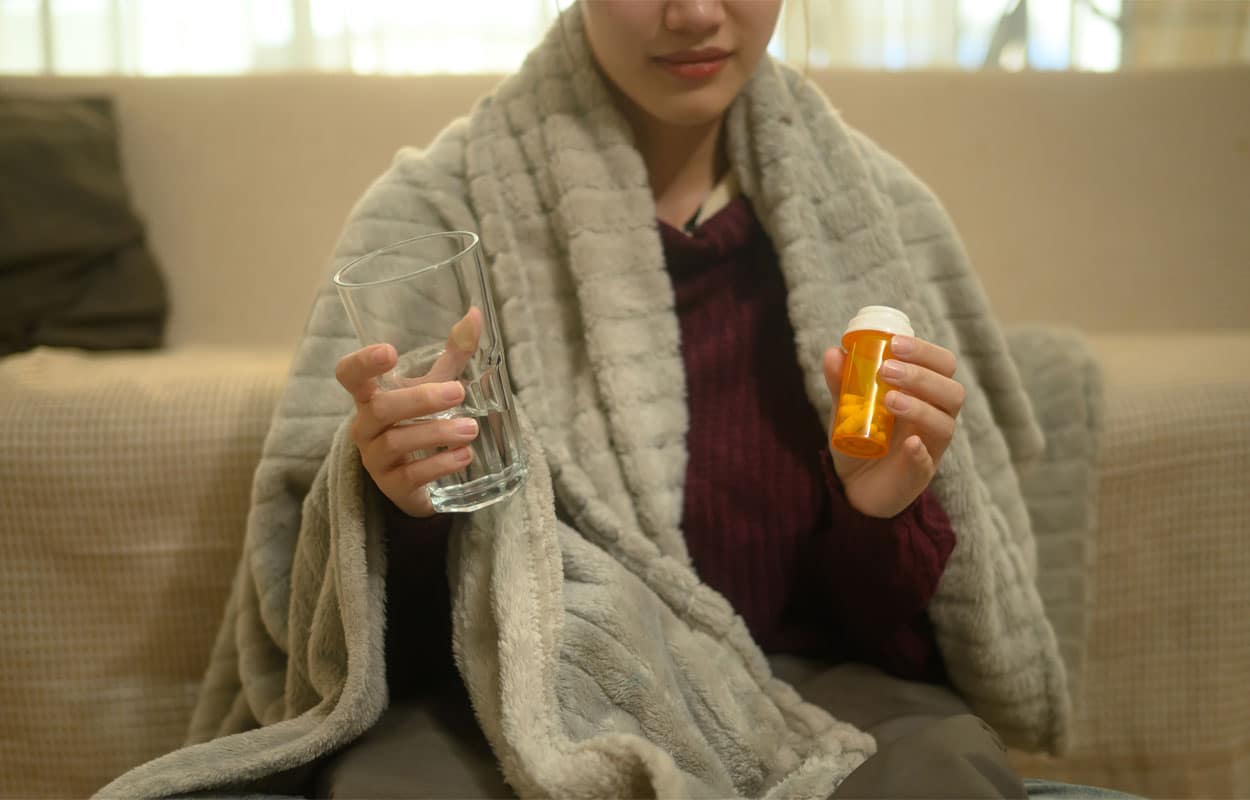
What Is A Gabapentin Overdose? Causes, Symptoms, and Treatment
Key Points
- When used as prescribed, Gabapentin overdose is rare.
- Overdoses that combine gabapentin with other substances are more dangerous than gabapentin alone.
- Gabapentin overdose alone can range from mild to severe symptoms, depending on individual risk factors such as renal function, age, and dosage. Symptoms can include drowsiness, dizziness, rapid heart rate, low blood pressure, nausea, vomiting, and a lack of coordination.
- Severe cases of gabapentin overdose may result in symptoms including lethargy, coma, and even death.
- Gabapentin combined with alcohol, opioids, or benzodiazepines is particularly dangerous.
- Call Poison Control or 911 if you suspect someone has taken too much gabapentin.
Gabapentin (tradename Neurontin) is a prescription-only anti-seizure medication.[1] It’s also prescribed for treating restless leg syndrome and postherpetic neuralgia–nerve pain that lingers after shingles. It is widely used to lower the severity of fibromyalgia and peripheral neuralgia. Gabapentin is sometimes prescribed off-label to help manage mental health issues like anxiety.
However, overdose deaths involving gabapentin are rising.
Understanding Gabapentin
Gabapentin is a non-narcotic drug belonging to the gabapentinoid family. The FDA approves Gabapentin for treating partial seizures and postherpetic neuralgia. It is also approved for moderate to severe primary restless legs syndrome under the brand name Horizant, which contains gabapentin enacarbil, not gabapentin itself. Also known by its brand name, Neurontin, gabapentin is a commonly prescribed anticonvulsant. Over 73 million prescriptions for it were written in 2024.[2]
Side Effects of Gabapentin
Gabapentin modulates the release of excitatory neurotransmitters by binding to the α2δ subunit of voltage-gated calcium channels, primarily in the CNS. Because it acts directly on the brain and spinal cord to reduce nerve activity, even when taken as prescribed, gabapentin can produce the following side effects:[3]
- Slow breathing
- Drowsiness
- Fatigue
- Dizziness
- Headache
- Nausea and vomiting
- Movement problems: poor coordination, falls
- Difficulty speaking
- Memory loss
- Eye problems: unusual eye movements, double vision
- Diarrhea
Gabapentin Abuse
The Drug Enforcement Agency (DEA) reports that gabapentin is becoming increasingly abused in conjunction with sedative-hypnotics.[4] It’s this combination of gabapentin with other drugs, like opioids, that makes it dangerous during an overdose.
Unlike opioids, gabapentin is not a narcotic. However, people who abuse substances often combine gabapentin with other drugs to create or intensify the euphoric effects.[5] Gabapentin can enhance the depressant effects of other CNS depressants like opioids or benzodiazepines.
Some of the most dangerous drugs to mix with gabapentin include opioids and benzodiazepines. The adverse effects of gabapentin mixed with alcohol can also be deadly.
A person can overdose on gabapentin deliberately or accidentally. For healthy adults, an overdose of gabapentin can be treated without long-term harm. Older adults, young children, and those with kidney issues are more likely to have serious reactions to high doses of gabapentin.
The risk goes up even more when gabapentin is taken with other substances that slow the nervous system, like alcohol, opioids, or benzodiazepines. These combinations can cause breathing to slow or stop, which can be deadly without fast medical help. Even gabapentin alone can affect breathing, so mixing it with other depressants makes it especially dangerous
These are the most common signs and symptoms of an overdose on gabapentin:[6]
- Drowsiness
- Dizziness
- Rapid heart rate
- Low blood pressure
- Nausea
- Vomiting
- Lack of coordination
Severe cases of gabapentin overdose may result in symptoms including lethargy, coma, and even death.
Overdoses on Opioids and Gabapentin
An overdose involving both an opioid and gabapentin is hazardous because both drugs depress the central nervous system (CNS). Opioids are prescription painkillers and effectively relieve moderate to severe pain. Because of their usefulness as pain relievers, prescription opioids are plentiful and relatively easy to get. Unfortunately, all opioids can be addictive.
When gabapentin and opioids are taken together, a dangerous drug overdose becomes more likely.[7] Both opioids and gabapentin relax the nervous system and cause a person’s breathing to become slow and shallow, which can cause respiratory arrest. During respiratory arrest, a person’s breathing gradually slows, becomes increasingly shallow, and stops.
Common drugs in the opioid class include:
- Fentanyl
- Hydrocodone
- Codeine
- Oxycodone
- Morphine
- Tramadol
- Heroin
Heroin is a commonly abused opioid that has no legal use. It is highly addictive and easy to overdose on.
Gabapentin calms overactive nerves inside the brain and spinal cord. As a side effect, it can reduce and shallow a person’s breathing. When gabapentin is taken by itself, even in an overdose, this side effect is mild. However, when combined with other substances, taking too much gabapentin could be life-threatening.
Physical Signs of Opioid and Gabapentin Overdose
An overdose involving both an opioid and gabapentin is hazardous because both drugs depress the central nervous system (CNS). If you’re concerned that someone may have taken opioids and gabapentin together, watch for the following signs of:[8]
- Extreme sedation or unresponsiveness (can progress to coma)
- Very slow or stopped breathing (respiratory depression)
- Bluish lips or fingertips (cyanosis from lack of oxygen)
- Pinpoint pupils (classic sign of opioid overdose)
- Weak pulse or low blood pressure
- Cold, clammy skin
Mental/Cognitive Signs of Opioid and Gabapentin Overdose
- Severe confusion or delirium
- Dizziness or loss of coordination
- Slurred speech
- Hallucinations (especially with high doses of gabapentin)
Gabapentin alone rarely causes fatal overdose, but it potentiates (increases and aggravates) the dangerous side effects of opioids.
Benzodiazepine and Gabapentin Overdose
Benzodiazepines are prescription medications that treat anxiety, muscle spasms, panic attacks, seizures, and insomnia. Like gabapentin, they slow the activity of the central nervous system and should not be taken together. A few typical benzodiazepines include:
- Lorazepam (Ativan)
- Alprazolam (Xanax)
- Diazepam (Valium)
- Clonazepam (Klonopin)
- Temazepam (Restoril)
- Chlordiazepoxide (Librium)
As the use of gabapentin is increasing throughout the nation, drug overdoses on gabapentin mixed with benzodiazepines are also becoming more common.[9]
Gabapentin and Alcohol Increase the Risk of Overdose
Taking gabapentin while drinking alcohol is risky and not recommended. Both can make a person feel sleepy, dizzy, and unsteady. When taken together, these effects become more powerful. One of the biggest dangers in mixing alcohol and gabapentin is that they both slow breathing. Drinking alcohol and taking gabapentin can gradually slow a person’s breathing so much that it stops.
The risk is even higher for people who have kidney disease, lung problems, or other health issues. Mixing these substances is never safe and can lead to an overdose or even death.
Gabapentin Overdose Special Warnings
People with breathing problems, kidney disease, or mental health conditions may be more likely to have serious complications from a gabapentin overdose. Those taking medications for mental health issues or struggling with substance use are also at higher risk.
Gabapentin Overdose Deaths
Overdose deaths involving gabapentin have risen steadily over the last decade, with a 20% surge in 2020. At that time, 32% of all overdose deaths involved gabapentin. Of those deaths, around 85% were coupled with an opioid. [10]
Because gabapentin isn’t always included in postmortem toxicology reports, these figures may underreport the number of deaths from gabapentin overdose.[11]
What to Do For A Gabapentin Overdose
Following the recommended use, Gabapentin overdose is rare. If you suspect someone is experiencing a gabapentin overdose, call poison control immediately or 911 if it is a life-threatening emergency, and stay with the individual. If you or a loved one is struggling with substance abuse, recovery is possible. Drug rehab can return you to the life you deserve. It is never a bad time to seek treatment.
Frequently Asked Questions About Gabapentin Overdose
Is gabapentin a controlled substance?
Gabapentin is not a federally controlled substance, but as of 2024, at least 12 U.S. states have classified it as a Schedule V or similar controlled substance.
Why would someone abuse gabapentin if it’s not a narcotic?
Gabapentin enhances and intensifies the effects of other drugs like opioids and benzodiazepines. Some people misuse it to boost their “high” or calming effects.
Can gabapentin make opioids or benzos more dangerous?
Gabapentin can enhance the sedative and respiratory depressant effects of opioids and benzodiazepines when used together, increasing the risk of serious adverse outcomes such as respiratory depression and overdose. However, gabapentin is not technically classified as a general “potentiator.”
How common are gabapentin-related overdose deaths?
In 2020, gabapentin was detected in around 1 out of every 3 lethal drug overdoses, usually in combination with opioids.
Does gabapentin cause breathing problems by itself?
Yes. Gabapentin can cause shallow breathing, but it’s usually mild.
Can you develop a tolerance to gabapentin?
Yes. Some users may build up a tolerance over time, which can lead to taking larger amounts, increasing the risk of a dangerous overdose, especially when combined with other substances.
How can I lower the risk of accidental overdose?
Follow your doctor’s dosage exactly. Never mix gabapentin with alcohol, opioids, or sedatives unless prescribed. Store it safely and keep it out of reach of others who might misuse it.
Does a gabapentin overdose always occur due to drug abuse?
No. Some overdoses are accidental, especially in people with kidney problems or in those who take a double dose by mistake. Mixing with other medications can also raise the risk.
Sources
[1][3]Cleveland Clinic. (2025, June 26).Gabapentin: Uses, side effects, dosages, Interactions & More. Cleveland Clinic.https://my.clevelandclinic.org/health/drugs/21561-gabapentin
[2][4]Gabapentin (trade name: Neurontin®). (n.d.-a). https://www.deadiversion.usdoj.gov/drug_chem_info/gabapentin.pdf
[5]Hägg, S., Jönsson, A. K., & Ahlner, J. (2020, December). Current evidence on abuse and misuse of gabapentinoids. Drug safety.https://pmc.ncbi.nlm.nih.gov/articles/PMC7686181/
[6]Neurontin (gabapentin): Side effects, interactions, and overdose. Neurontin (Gabapentin) | Poison Control. (n.d.-a). https://www.poison.org/articles/neurontin-gabapentin
[7]NBCUniversal News Group. (2018, April 1). Health officials are sounding an alarm on the drug gabapentin. and it’s not even an opioid. NBCNews.com. https://www.nbcnews.com/storyline/americas-heroin-epidemic/health-officials-are-sounding-alarm-drug-gabapentin-it-s-not-n861111
[8]Mayo Foundation for Medical Education and Research. (n.d.). Gabapentin (oral route). Mayo Clinic. https://www.mayoclinic.org/drugs-supplements/gabapentin-oral-route/description/drg-20064011
[9]Olopoenia, A., Camelo-Castillo, W., Qato, D. M., Adekoya, A., Palumbo, F., Sera, L., & Simoni-Wastila, L. (2022, June 23). Adverse outcomes associated with concurrent gabapentin, opioid, and benzodiazepine utilization: A nested case-control study. Lancet regional health. Americas. https://pmc.ncbi.nlm.nih.gov/articles/PMC9904085/
[10]Centers for Disease Control and Prevention. (2024, April 4). Notes from the field: Trends in gabapentin detection and involvement in drug overdose deaths – 23 states and the District of Columbia, 2019–2020. Centers for Disease Control and Prevention. https://www.cdc.gov/mmwr/volumes/71/wr/mm7119a3.htm
[11]Cdcmmwr. (2024, April 4). Notes from the field: Trends in gabapentin… Centers for Disease Control and Prevention. http://dx.doi.org/10.15585/mmwr.mm7119a3


